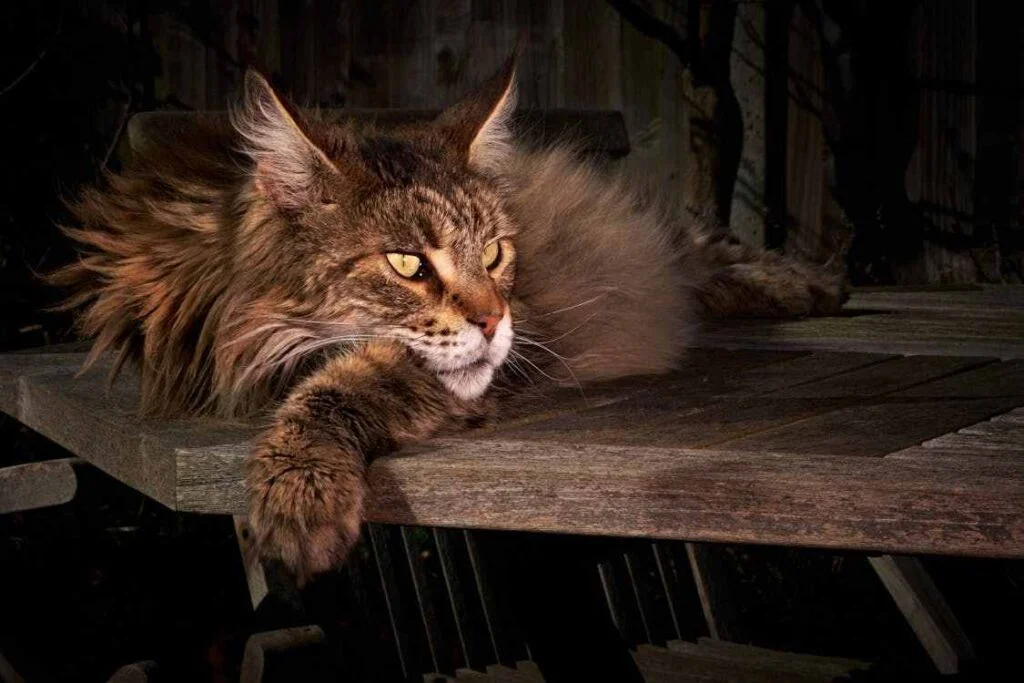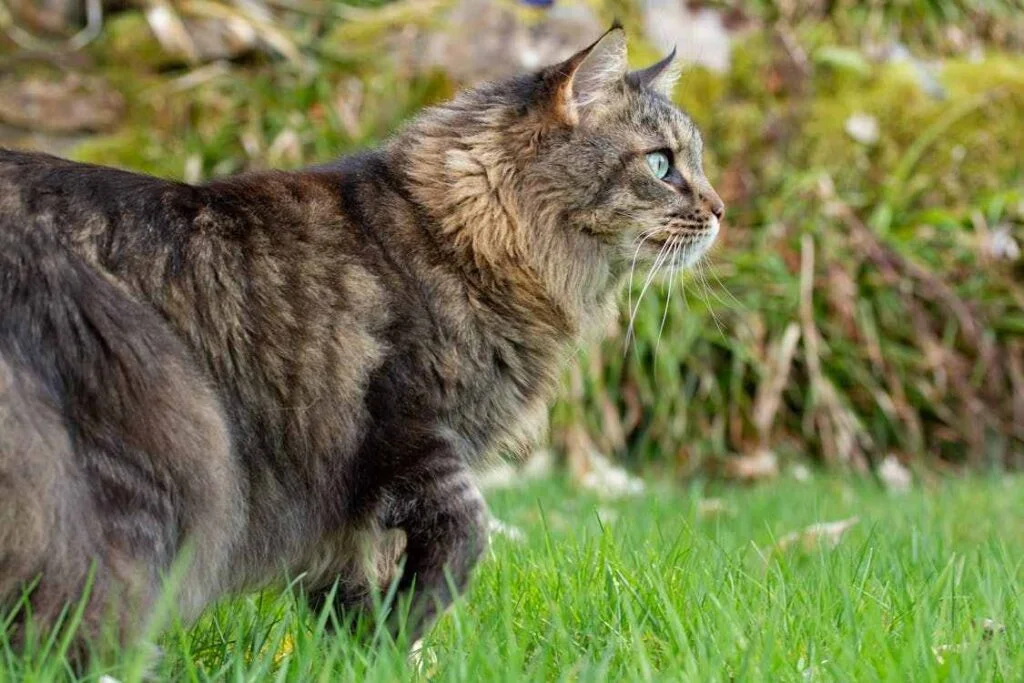Maine Coon cats are a noble, beloved breed. They are known for their large size, luxurious coat, and gentle, puppy-like personality. These magnificent cats have a unique appearance. But some Maine Coons have an extra trait: extra toes, known as polydactyly. All cats have 18 toes: five on each front paw and four on each hind paw. Polydactyl Maine Coons can have 20, 22, or even more!
Why do some Maine Coons have extra toes? This question has intrigued breeders, cat owners, and researchers alike. The answer lies in a mixture of genetics, history, and maritime folklore. Polydactylism holds a unique place in both cat and sailing history. This guide will explore the science and lore behind this trait. It is widespread in Maine Coons from the northeast coast of North America. Genetic and cultural backgrounds of polydactylism.
What Is Polydactylism?
Polydactylism is a genetic mutation. It causes cats to have more than 18 toes. This trait, called “hyperdactyly,” is inherited through a dominant gene. Only one parent needs to have the gene for a kitten to inherit it. Polydactylism can occur in any cat breed. But, it is common in Maine Coons, especially in North American breeds.
In polydactyl cats, the extra toes can vary in number and location. Some may have extra toes on only the front paws, while others may have all four. This unique feature has led to the nickname “Mitten Cats.” Broad claws often resemble small teeth. People have had adorable polydactyl cats like Maine Coons for centuries. Many owners see this feature as an endearing quirk that adds to the cats’ individuality.

Genetic Basis of Extra Toes in Maine Coons
Polydactylism is due to a mutated Pd gene. It controls digit growth during development. A change in this gene causes extra digits. A simple dominant inheritance pattern passes on this trait. A male coon with polydactylism needs to inherit one mutated gene from one parent to show the trait. If one parent has extra fingers, their children are likely to have them too.
For breeders, this trait makes it easy to produce polydactyl male cones if desired. Polydactylism doesn’t usually affect a cat’s health. But it is a defining trait in some Maine Coon lines. This trait has gained attention. Enthusiasts seek it for its unique, historic polydactyl mane cones.
Why did this trait persist in Maine Coons? Early Maine Coon populations likely benefited from polydactylism in snowy, rugged climates. Over generations, the trait became more common among Maine Coons. This led to a higher concentration of polydactyl cats within this breed.
How Common Are Polydactyl Maine Coons Today?
Folklore and practicality steep the history of polydactyl man-cones. In the 18th and 19th centuries, sailors kept polydactyl cats on ships. They believed the “many-toed” cats brought good luck. They also thought the extra toes made the cats more stable on deck. There is a growing belief that polydactyl cats are better at balancing. These cats were often used to keep rats at bay on long sea voyages.
As ships from Europe arrived in North America, they likely brought polydactyl cats. These cats likely found new homes in Maine’s coastal towns. Here, Maine Coons with polydactylism became popular for their ability to navigate icy, rough terrain. Their extra toes acted as “snowshoes” to prevent them from sinking into the snow. This link between polydactyl cats, sailors, and coastal life is part of the Maine Coon’s heritage.
The Sailor’s Legacy: Due to this nautical link, Polydactyl Maine Coons are sometimes called “Hemingway cats.” This is after the writer Ernest Hemingway, who kept polydactyl cats at his home in Key West, Florida. Today, polydactyl mane cones are a beloved part of the breed’s history. People admire them for their unique look and the legends surrounding them.

The Significance of Polydactyl Maine Coons
When it comes to Maine Coons, the presence of extra toes is not just a unique trait – it holds significant appeal for breeders and cat enthusiasts alike. The polydactyl anomaly, characterized by additional toes on the paws, adds to the charm and individuality of these remarkable felines.
The demand for polydactyl Maine Coons has skyrocketed in recent years, with breeders recognizing the allure of this genetic anomaly. These cats are highly sought after for their distinctive mitten-like paws, also known as “snowshoe paws,” which enchant many with their unusual appearance.
Despite being a mutation, polydactylism in Maine Coons is not considered a flaw or a hindrance to their overall health. It is often seen as a desirable trait that sets them apart from other cats. The additional toes add to their agility, giving them a bit of an advantage when it comes to climbing, hunting, and even playing with toys.
How Common Are Polydactyl Maine Coons Today?
Polydactylism is less common in modern Maine Coons than in the past, partly due to changes in breeding methods. In the past, polydactylism was a naturally occurring trait in Maine Coons, especially in the Northeast coastal areas. Today, some breeders specifically choose against it to adhere to breed standards set by cat associations. But, many enthusiasts seek polydactyl mane cones. They want their unique look and history.
Polydactyl Maine Coons are rare but available. Some breeders focus on preserving traditional traits. Maine Coon fans value genetic diversity and history. They often appreciate polydactylism in the breed.
Do Extra Toes Affect a Maine Coon’s Health?
In general, polydactylism in Maine Coons does not cause health problems, making it a benign genetic trait. However, extra toes sometimes require extra attention, especially when it comes to nail care. Polydactyl Maine Coons need regular check-ups. Their nails can grow too long if left untrimmed. This can cause discomfort or infection. can cause
Owners should know that extra toes can cause trauma. They may be more prone to injury, especially in active or outdoor cats. A quick routine paw checkup can help prevent any minor problems from becoming more serious.
Polydactyl Maine Coons as Pets: Unique and Lovable!
Polydactyl Maine Coons make wonderful, charming pets. Many owners find that extra toes add to their cats’ unique personalities, giving them a cute look that stands out. Polydactyl Maine Coons have a gentle temperament. They are often friendly and loyal. So, they suit families and singles alike.
To adopt a Polydactyl Maine Coon, check breed-specific rescues, local shelters, or breeders who know the trait. These cats bring a piece of history with them, and for many owners, having a “Hemingway cat” adds a layer of charm to their home.
Conclusion
Polydactyl Maine Coons represent an interesting combination of genetics, history, and personality. These cats have a legacy of resilience and charm. It comes from their seafaring past and glacial origins in the northeastern U.S. Their extra toes, though not a health issue, are popular. They remind fans of the Maine Coon’s rich heritage. For cat lovers, adopting a polydactyl male coon is more than just owning a pet.
FAQs
Q: Why do some Maine Coons have extra toes?
A: Some Maine Coons have extra toes due to a genetic trait known as polydactyly, which causes them to have more than the typical number of toes on each paw.
How rare is a polydactyl Maine Coon?
Polydactyl Maine Coons are relatively uncommon but not extremely rare. Historically, up to 40% of Maine Coons in New England had polydactylism. Natural selection in their snowy environment caused this. However, selective breeding has reduced its frequency today.
Q: Is having extra toes on a Maine Coon a sign of good luck?
A: In some cultures, having a polydactyl cat, like a Maine Coon with extra toes, is considered a sign of good luck.
Q: How many toes can Maine Coons with extra toes have?
A: Maine Coons with polydactyly can have up to seven toes on each front paw, totaling up to 28 toes in total.
Are polydactyl cats friendlier?
Polydactyl cats aren’t inherently friendlier than non-polydactyl cats. Their friendliness depends more on personality and socialization than the number of toes. Many owners find polydactyl cats charming, but temperament varies by cat.

Hey guys, My name is Simon Smith. I’m from Canada and live near Victoria
I live with my sweet family and have 20+ Ragdolls of different types. I love them as my children. My profession is as a hotel manager.
I love to keep Ragdolls and grow their breeder case. I have 7 years of experience.
I’m an expert in cat care. So, I’m here to provide you with new information about my cats daily. This is my blog website, so I request that you kindly visit our site daily.
If you’re a Ragdolls lover and you have any questions or confusion about cats, text me on the Contact Us page or Gmail.
Thank u
